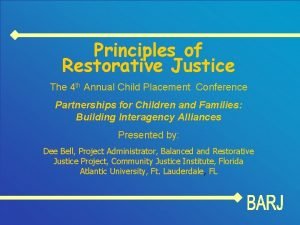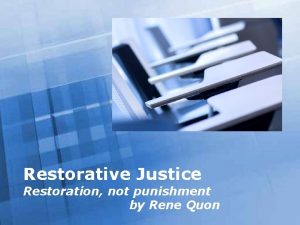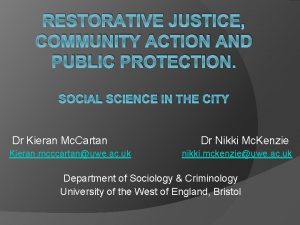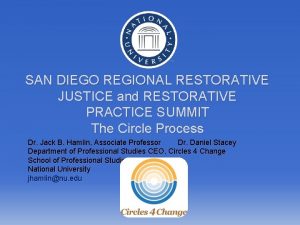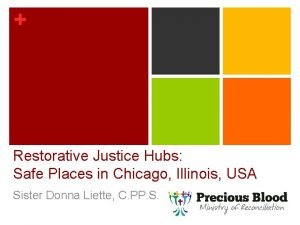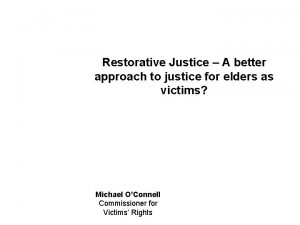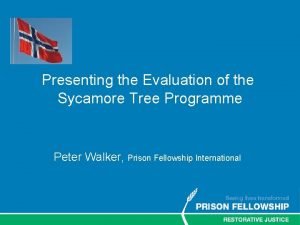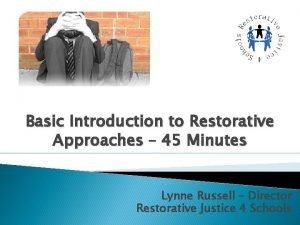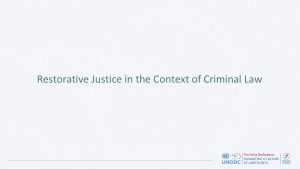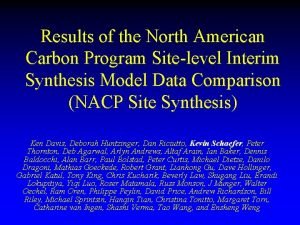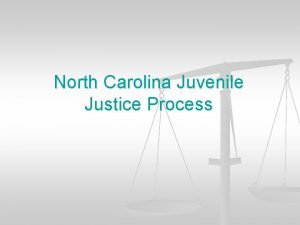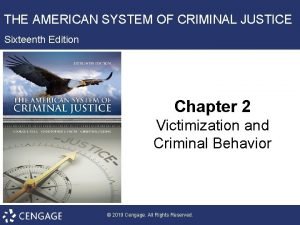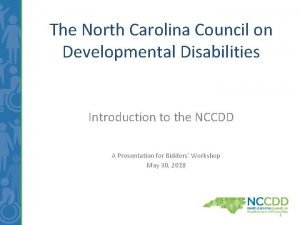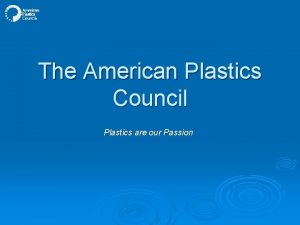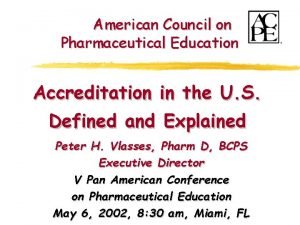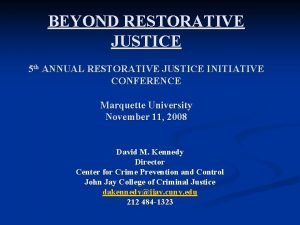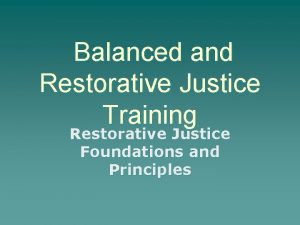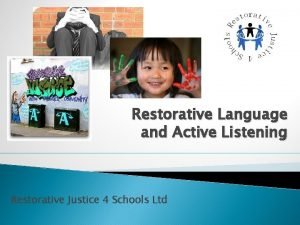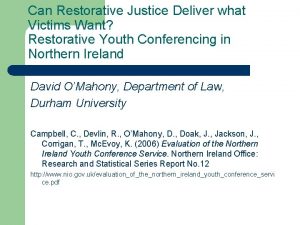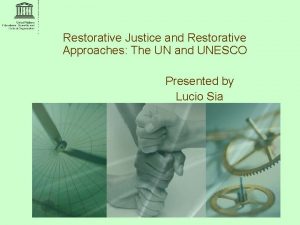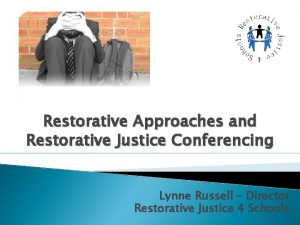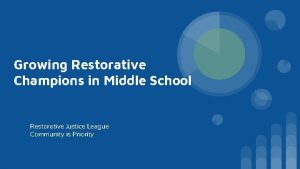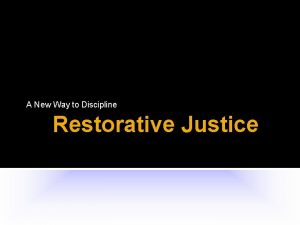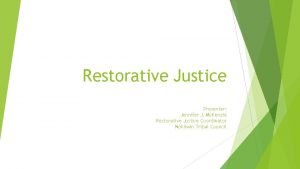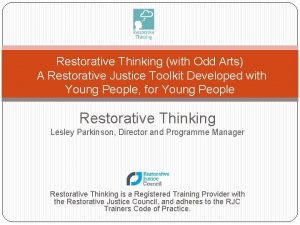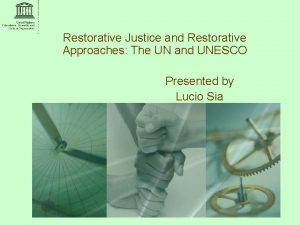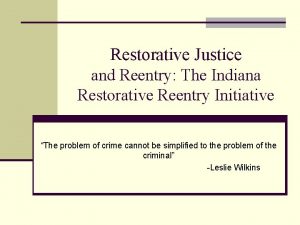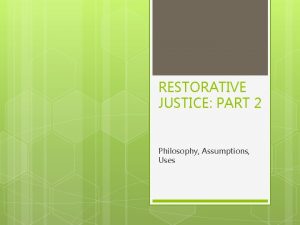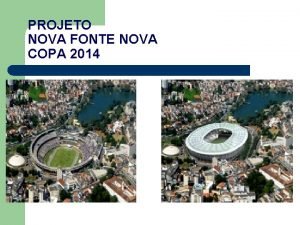Nova Scotia Restorative Justice Program North American Council




























- Slides: 28

Nova Scotia Restorative Justice Program North American Council for Juvenile Justice November 5 th, 2015 Janet Briggs Manager NSRJP

Nova Scotia’s Restorative Justice Program: (NSRJP)

Presentation Overview: • • • Nova Scotia Department of Justice: Vision, Priorities, and RJ History, Legislation and Policy connection Innovative Program – Best Practice Standards & Protocols Multi-Level Entry Points Changing Demographics Future Focus - Relational Approach to Healthy & Safe Communities

Authorization • Approved by the Attorney General for Nova Scotia as a Program Of Alternative Measures pursuant to and • as a program of extrajudicial sanctions pursuant to and • Section 10 Of The Youth Justice Act (Nova Scotia).

Nova Scotia Restorative Justice Program: Background (cont’d)

NS Department of Justice Strategic Plan 2015 - 2018 Vision: “Nova Scotia has a people-centred justice system and the safest communities in the country. ”

NS Department of Justice 2015 -16 Statement of Mandate… Priority areas: • Improving access to justice, • Working together for community safety and wellbeing: – Working with partners and communities to support innovative initiatives to prevent and reduce crime and victimization (Restorative Justice)

The NSRJ Program – at a glance • • • Provincial Government Funded; 8 Community Based Agencies; 1 Aboriginal Organization; Not-for-profit Board Governance Partnerships Established Through Collaboration & Consultation: • • Communities; Police & other justice partners; University researchers & academics; Other government departments

History, Legislation & Policy Connection Key Dates: • 1997 – Department struck a Multi-disciplinary Steering Committee to develop a System-wide Restorative Justice Initiative For Nova Scotia – Intention behind mandate centered on the Department’s Commitment To Improving The Delivery Of Justice Services • 1999 – NSRJP was launched in November for youth 12 -17

History, Legislation & Policy Connection Key Dates: • 2003 – YCJA proclamation & NSRJ Program deemed NS’s Program of “Extra Judicial Sanctions” • 2004/05 – Formal Program Protocols & Best Practice Standards developed (Collaborative process community partners & CJS stakeholders) • 2011 – Adult RJ Pilot Program launched in February in two areas of province

Nova Scotia Restorative Justice Program Our Pillars of Strength: Rel a sh tion Relational Impacts s “Victim” n e c tion Con ip “Community” “Offender”

Innovative Program NSRJ Program Goals & Objectives The Restorative Justice Program is designed to: • Reduce Recidivism • Increase Victim Satisfaction • Strengthen Communities • Increase Public Confidence In The Justice System

Innovative Program NSRJ Program Goals & Objectives • REDUCE RECIDIVISM – it has been shown that face-to-face meetings with victims can have a profound effect on the future behaviour of offenders – the nature of the restorative process provides an opportunity to focus on the underlying causes of the criminal behaviour and the constructive reintegration of the offender into the community.

Innovative Program NSRJ Program Goals & Objectives • INCREASE VICTIM SATISFACTION – by having a forum in which victims can discuss the impact of the offence and identify the reparative measures to be taken, they will derive greater satisfaction.

Innovative Program NSRJ Program Goals & Objectives • STRENGTHEN COMMUNITIES – by promoting a restorative approach which invites community participation in achieving reconciliation between offenders and those harmed through the commission of an offence.

Innovative Program NSRJ Program Goals & Objectives • INCREASE PUBLIC CONFIDENCE IN THE JUSTICE SYSTEM – greater participation by communities and victims in community-based restorative justice processes as an alternative or supplement to the formal criminal justice system will enhance public confidence.

NS Restorative Justice Program: “For” “By” COMMUNITY “In”

Innovative Program Key principles of NSRJP • • • A Process Orientation A focus on Needs Respect Flexibility Accountability Victim Voice • Empowerment • Community Participation and Connectedness • Inclusiveness and balance • The voluntary Nature of the Process

NSRJ Program Protocols • Program Protocols Include: – Program Goals/Objectives – Eligibility criteria – Referral processes – RJ process options – RJ Agreements – Supervision of Agreements – Administrative Requirements – Agency Standards

Multi-level Entry Points REFERRAL can be made from four distinct entry points in the criminal justice system: • Peace Officer Entry Point - pre-charge • Crown Attorney Entry Point - post-charge/pre-finding of guilt • Court Entry Point - post-finding of guilt/pre-sentence (Referral by judges ) • Corrections Entry Point - post-sentence Note: Providing the seven eligibility criteria on the referral checklist are met. At all times the youth must accept responsibility for their behaviour and participation must be voluntary.

Innovative Program Nova Scotia Restorative Justice Program Adult RJ Pilot (2011 - ongoing) • Expansion in two pilot sites to provide early intervention for Adults using a revised adult diversion framework • Shared-Skills Model with RJ agencies & Community Corrections • Two referral points at present (Pre-charge & Post-charge) • Rigorous evaluation - two year mark showed strong success and stakeholder engagement

Innovative Program Nova Scotia Restorative Justice Program The value added this programs brings to the criminal justice system and to crime reduction: Volunteer led accountability processes that engage youth High success rate Culturally specific approaches Moves cases away for the formal system, thereby supporting overall cost savings • Increases access to justice in timely manner • Offers a voice and community led support for victims of crime • Builds community level leadership in guiding youth to better choices • •

Future focus/Ongoing work • Strengthening victim & community engagement • Municipal leaders increased involvement • Changing demographics of offenders and community - fewer youth vs increased older offenders • Need for inclusion of marginalized offenders who require a different approach than broader population

Future Focus NS is expanding the use of restorative practices beyond the court room… • • Schools & classroom - RAISP Workplace disputes/discipline/grievance Situations of Elder Abuse Human Rights disputes Youth facilities – in care & detention University settings also exploring it’s utility with Restitution Collection

Expanding Innovation: • Increasing community and victim engagement; • Increasing use and application of restorative options; • Incorporating restorative options and relational approaches into everyday Nova Scotia living; • Realizing a safer, healthier community and engaged citizenship.

Nova Scotia Restorative Justice Program ing Build nships io Relat ACCOUNTABILITY hy ities t l a n He mu m Co SAFETY RELATIONSHIPS Access to Justice + In con clusio n nec ted / PARTNERSHIPS

Nova Scotia Restorative Justice staff 2013 Nova Scotia Restorative Program Agency Staff 2014

Thank you Contact Information: Janet. briggs@novascotia. ca
 Nova scotia teaching certificate
Nova scotia teaching certificate Bishop poetry leaving cert
Bishop poetry leaving cert Nature conservancy of canada nova scotia
Nature conservancy of canada nova scotia Principle of restorative justice
Principle of restorative justice Restorative justice template
Restorative justice template Social justice and community action
Social justice and community action San diego restorative justice
San diego restorative justice Restorative justice hubs chicago
Restorative justice hubs chicago Pros and cons of restorative justice
Pros and cons of restorative justice Sycamore tree restorative justice
Sycamore tree restorative justice Peter woolf and will riley
Peter woolf and will riley Restorative justice script
Restorative justice script Restorative justice definition
Restorative justice definition Principles of restorative justice
Principles of restorative justice Council rock north program planning
Council rock north program planning North american carbon program
North american carbon program North carolina juvenile justice
North carolina juvenile justice Harta geografica a angliei
Harta geografica a angliei The american system of criminal justice 16th edition
The american system of criminal justice 16th edition Criminal justice wedding cake diagram
Criminal justice wedding cake diagram North carolina council on developmental disabilities
North carolina council on developmental disabilities True north vs magnetic north
True north vs magnetic north Integrated care system north east
Integrated care system north east Lesson 1 the industrial north
Lesson 1 the industrial north The north pole ____ a latitude of 90 degrees north
The north pole ____ a latitude of 90 degrees north American plastic distributors
American plastic distributors Council of american states in europe
Council of american states in europe American council on pharmaceutical education
American council on pharmaceutical education American council for technology
American council for technology



